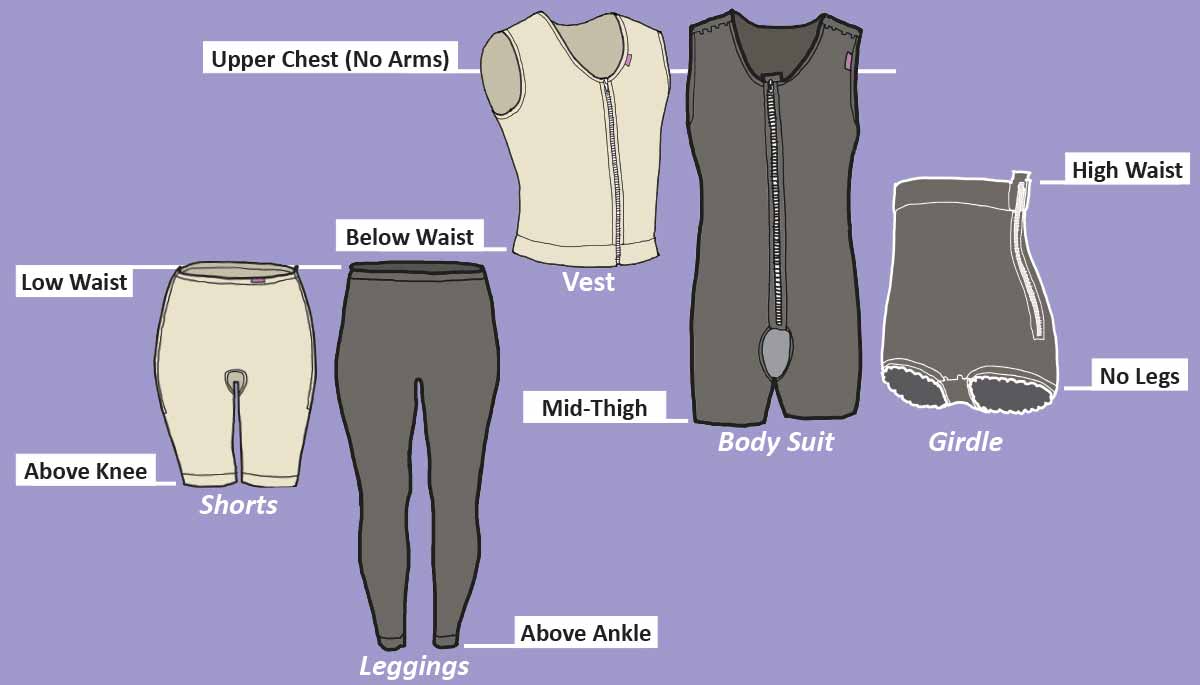


Garment types are Body Suit (torso), Vest (upper torso), Girdle (lower torso), Shorts (lower torso and leg) and Leggings (lower torso and leg).
Torso Vests can finish below the waist or at the hips. Girdles, Shorts and Leggings can have a high or low waist. Longer or shorter torso lengths can affect the extent of cover.
Arms When a sleeve is added the shoulders are also covered. Typical sleeve lengths are above or below the elbow or above the wrist.
Legs Typical lengths are just below the groin (Boy leg), mid-thigh, above the knee, below the knee (Capri leg), above the ankle or over the foot.
Material A mix of synthetic yarns is typically needed to provide compression.
Labels Printed on the inside or a cloth label sewn on the outside to avoid skin marking and/or irritation.
Seams Raised profile sewn seams to the outside to avoid skin marking and irritation. Heat glued flat seams can be on the inside or outside.
Straps When applicable, are typically detachable with a sliding adjustment buckle or attached and openable hook-and-eye clip adjustment.
Cups When applicable, are usually heat moulded soft elasticised material that shapes itself to the breast.
Fastener Types Hook-and-eye clips are typically used on the garment and/or openable shoulder straps. Zips are used on the garment and typically underlain with clips that take the stress of the zip when being closed. No fastener garments, sometimes called ‘pull-on garments’, need to be gently worked up the body to avoid damaging the fabric.
Fastener Position & Length Hook-and-eye clips are typically positioned at the front of the garment. There can be less stress on an abdominal incision with a front fastener. Zips can be at the front, to one side or both sides of the garment. Doing up a side fastener results in twisting the abdomen and this can stress the incision. Generally, fasteners are better positioned away from areas of liposuction to avoid marking the skin, and a longer fastener can make putting-on easier.
Adjustment More hook-and-eye clip adjustment positions on the garment and shoulder straps can improve fit and give more scope for adjustment as swelling reduces. Zips do not allow for adjustment.
Crotch A closed (no opening) crotch avoids seams marking the area of surgery but means the garment must be removed for toileting. With care, an open crotch may allow toileting without removing the garment. A hook-and-eye closure crotch flap can be used to increase fit adjustment and, when undone, allows the bottom of the garment to be turned up for toileting.
Compression The capacity of the garment to provide firm and even support and pressure. When tested, compression is measured in ‘millimetres of mercury (mmHg)’. Generic terms such as ‘medical grade’ do not quantify performance. Research suggests compression performance reduces with wear.
Moisture The capacity of the material to absorb sweat and then release it to the atmosphere. Test outcomes typically show ‘high to low’ or similar rating. Generic terms such as ‘breathable’ do not quantify performance. Research suggests synthetic elasticised materials like those used in compression garments may have similar moisture performances.
Anti-Bacterial Material resistance to the transmission of skin borne bacteria and fungi, wound discharge, mould growth and the like that can be embedded in the close-fitting material. Generic terms such as ‘active resistance’ does not quantify performance. Research suggests personal hygiene, garment care and single person wear may be more important.
Free from Harmful Chemicals (Latex) When the OEKO-TEX Standard 100 Logo is shown on the garment label it indicates that the ‘finished garment’ has been tested and given an OEKO-TEX Certificate. Generic terms such as ‘OEKO-TEX materials’ do not verify ‘chemical free’ status.
Australian Register of Therapeutic Goods (ARTG) Medical use garments registered with the Therapeutic Good Administration of Australia.
Wash & Wear Performance Loss Repeated wash and stretch cycles can be used to test for compression loss after wearing and washing. Few manufacturers provide information, making it difficult to compare performance.
Links & Information
STUDIO RANGE Products Go to Compression Garments, click on a product to see ‘Style’ and ‘Look & Feel’ information, then click on the ‘Fitter’s Notes’ tab for more product information.
STUDIO
If You're in WA, Drop-in for a Fitting
31 Teddington Rd Burswood WA
Monday to Friday 10am to 4pm and Saturday 10am to 2pm
PHONE
Quick and Easy, from Anywhere in Australia
T (08) 9361 1300
ONLINE
Anywhere, Anytime, Purchase with Confidence from Our Australian ONLINE Fitting STUDIO